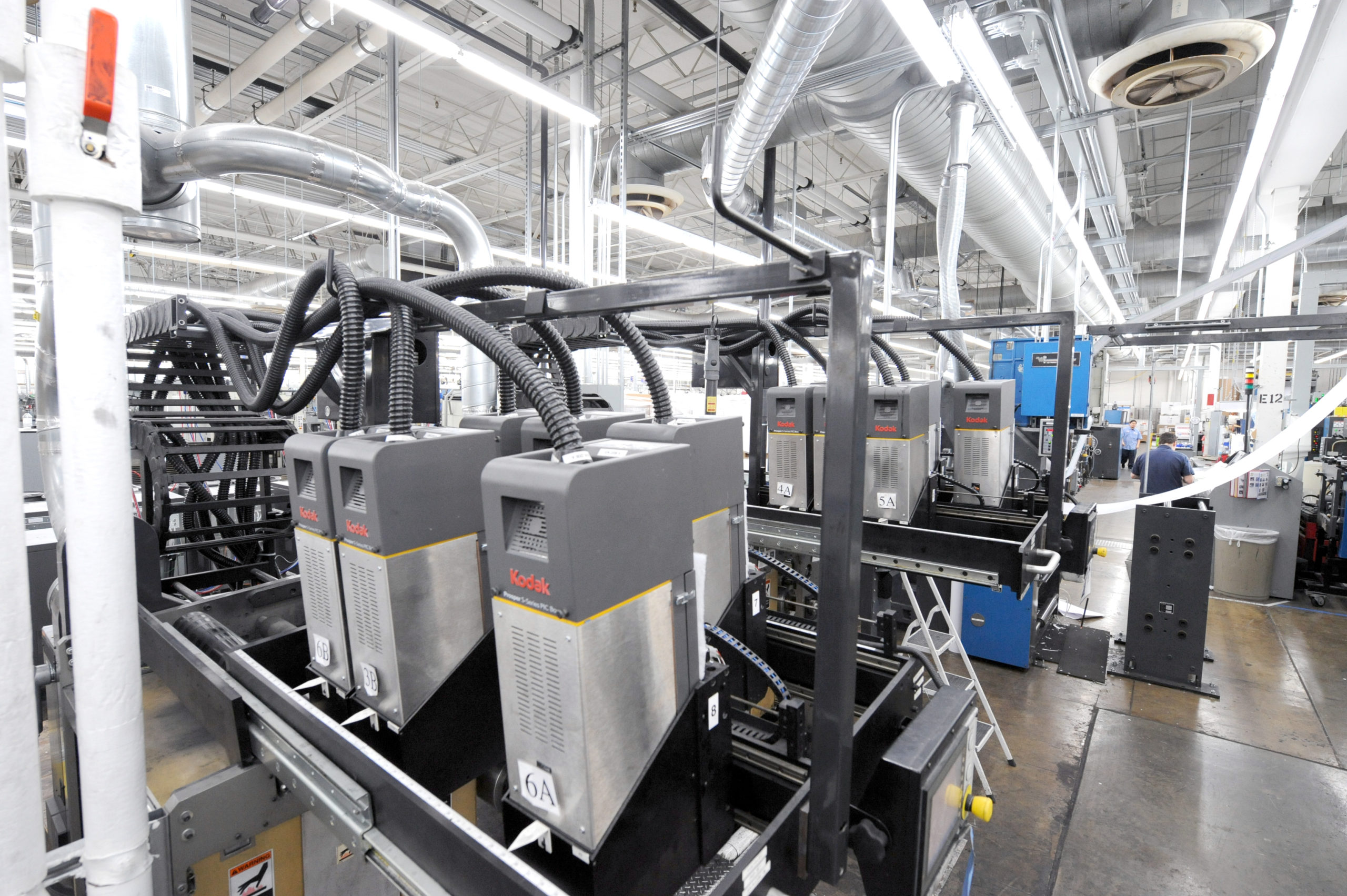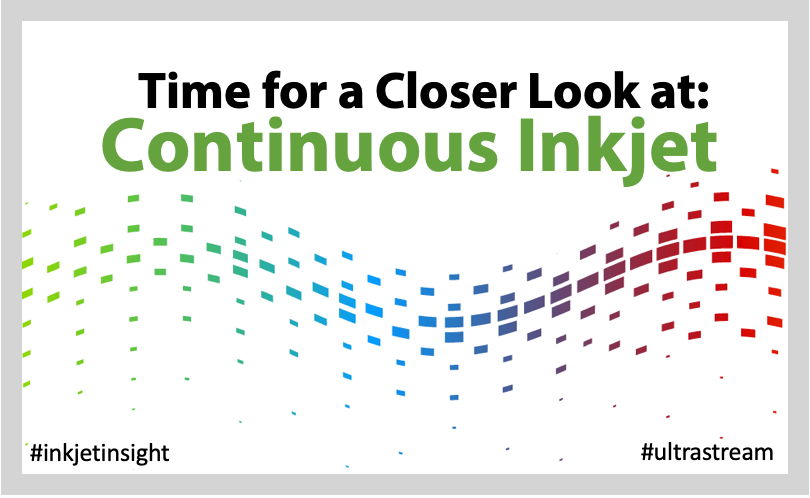Sponsored by Kodak
The productivity and quality characteristics of Continuous Inkjet (CIJ) that have made it the most widely installed technology in commercial environments were covered in a previous article “Continuous Inkjet Firmly Entrenched in Commercial Markets.” We continue the analysis of CIJ relative to Drop-On-Demand (DOD) technologies such as thermal and piezoelectric with a discussion of media compatibility, running costs and how all of these features work together to create new opportunities for commercial printers.
Achieving Media Compatibility
In theory, with DOD inkjet systems, drops are only produced when needed. In practice, DOD printheads “spit” a small amount of ink from heads when not fully forming a drop and add humectants to ink to prevent nozzle clogging. However; as soon as the ink hits the paper, it needs to be dried quickly and with limited spreading. That task is harder when an ink contains elevated humectant levels. Sure, humectants help keep the heads clear of dried ink, but they also make it harder for inks to dry, especially if the media is a glossy paper or flexible film. Thermal DOD ink chemistry is further challenged by the need for ink to boil which limits the ingredients that can be used.
In contrast, CIJ heads produce a non-stop curtain of drops which keep nozzles wetted and limit the need for ink additives. This has the triple benefits of improving substrate compatibility, enabling high-coverage and improving head life and reliability.
When used with specially formulated optimizers, Kodak CIJ heads expand compatibility beyond printing on uncoated, silk and gloss paper to printing on films for applications like flexible packaging, labels and signage. The Lettershop Group (TLG) runs litho presses, hybrid inkjet and litho and inkjet presses and uses the same papers for all three processes. The Kodak Prosper, when installed with pre-coating and post-coating “can produce the output the same as the litho press,” according to Simon Cooper, TLG’s Managing Director. “We don’t see any of the lines where the modules were stitching together or inconsistencies across the sheet when heads start wearing that we saw with the drop on demand systems.” (See sample applications below)
CIJ heads, and lower additive volume, also allow for smaller pigment particle sizes. Colorants provided as nano-particles deliver better color saturation and expand the color gamut beyond that of offset.

Inkjet postcard mailing: The Lettershop Group UK

Magazine cover: The Lettershop Group UK

Direct Mail: The Lettershop Group UK
Running Cost
As noted in the previous article, DOD systems sometimes double up on nozzles to achieve higher resolution or higher speed. However; streamlining the printing system lowers running costs. CIJ operates at top quality and top speed with fewer nozzles, less frequent down-time for maintenance, a lower level of ink additives, no wastage of ink for “spitting” and longer head life.
The lower materials costs and higher productivity of CIJ heads delivers economic break-even with offset at higher run lengths and an overall cost model that DOD systems can’t match. TLG reported that they run half a million letters in 4 hours on the Prosper. In fact, Cooper notes, “We replaced a litho sheetfed press with the Prosper.” While the higher break-even is critical, inkjet is still more expensive than offset. “If the customer’s happy with what they’re getting, and obviously it’s working for them, price isn’t the barrier,” says Cooper, “But the problem is, you’ll never get into that conversation unless you’re meeting the quality and the flexibility.”
Kodak CIJ heads have also been integrated into 3rd party presses and mounted on bespoke hybrid systems. This has led to numerous 3rd party evaluations of running costs. “Our running costs have come in 15% to 30% percent below competitors and we have been compared to almost every other technology out there. That includes thermal drop-on-demand and piezo drop on demand,” according to Randy Vandagriff Senior Vice President, Digital Print with Eastman Kodak.
Kodak CIJ printheads have been proven reliable when mounted on flexographic, offset and gravure presses with demonstrated quality levels to match commercial, packaging, and other demanding applications. These heads are equally reliable and precise when part of press systems like the Prosper family.
Savvy Customers Using CIJ
“You press the button. We do the rest” was a wildly successful marketing slogan for Kodak cameras years ago. For inkjet, Kodak has taken a different approach. They have not “dumbed down the equipment” to enable auto-maintenance but have made it easily maintainable by qualified staff.
Kodak customers recognize that they need a more technical staff to maintain the press but are very positive about the level of control it affords them; the training Kodak provides and the resulting consistency and reliability of the press. What matters most to them is delivering quality output at speed to their customers.
TLG does all of their equipment maintenance in house, and Cooper advises that CIJ heads “aren’t your average, first day on the job type of inkjets to maintain, but once you understand the technology and the difference and what you need to do to maintain them, the Prospers love to run. We have never had a worry or a thought of needing a second machine” for redundancy. Many DOD systems have maintenance that is more automated and suited to entry level operators, but maintenance may also be more frequent and require more down-time.
Minnesota-based commercial printer Japs-Olson Company has a fleet of 20 presses and runs about 15% of their work on continuous inkjet. Their COO, Patrick Murray noted that that they perform their own CIJ maintenance in-house. Murray is a strong Kodak advocate, “We know our business and our client’s and we know the advantage we have with the Kodak equipment. It’s taken us a long way and we’re going to continue to ride with it because we haven’t seen anything that’s surpassed it.” He adds, “What’s important to us is that quality, that speed, that consistency.”

Japs Olson production floor

Japs Olson Kodak Prosper 6000c installation
While there were several inkjet press launches in 2020 newly targeting the commercial print space with the ability to print on offset gloss stocks, it’s worth noting that Kodak has been serving this market for years and that Prosper CIJ presses are faster and more productive than any of the new releases, in some cases, more than 2 times the speed.
“When it comes to four color trying to match offset quality at high speed there’s nothing like the continuous inkjets. It really is different, and it works. And it’s not new, it’s been around for quite a while,” says Murray. TLG’s Cooper was equally bullish, commenting “We don’t have any customers saying we want better quality. We never have a discussion – it’s a given. The Prosper is more accurate than the litho and is more consistent from one month to the next.”
Taking Continuous to the Next Level
Kodak has also announced their latest technology upgrades with the PROSPER ULTRA 520 which doubles resolution in the cross-web direction over their Prosper 6000 technology. “We built STREAM technology to go after commercial print with image quality comparable to 150-175 line screen or 600×900 resolution, and it works for thousands of sites producing billions of pages,” according to Vandagriff. “ULTRASTREAM takes the next step to photo quality with 600×1800 resolution, a smaller drop size and a new generation of front-end controller that can scale based on customer needs. “
With a higher break even relative to offset, better media compatibility, high reliability, wide color gamut and output that customers say is indistinguishable from offset, isn’t it time to take a closer look at continuous inkjet options?
Editor’s Note: Alexandra Pekar, Inkjet Insight contributed to this article.

